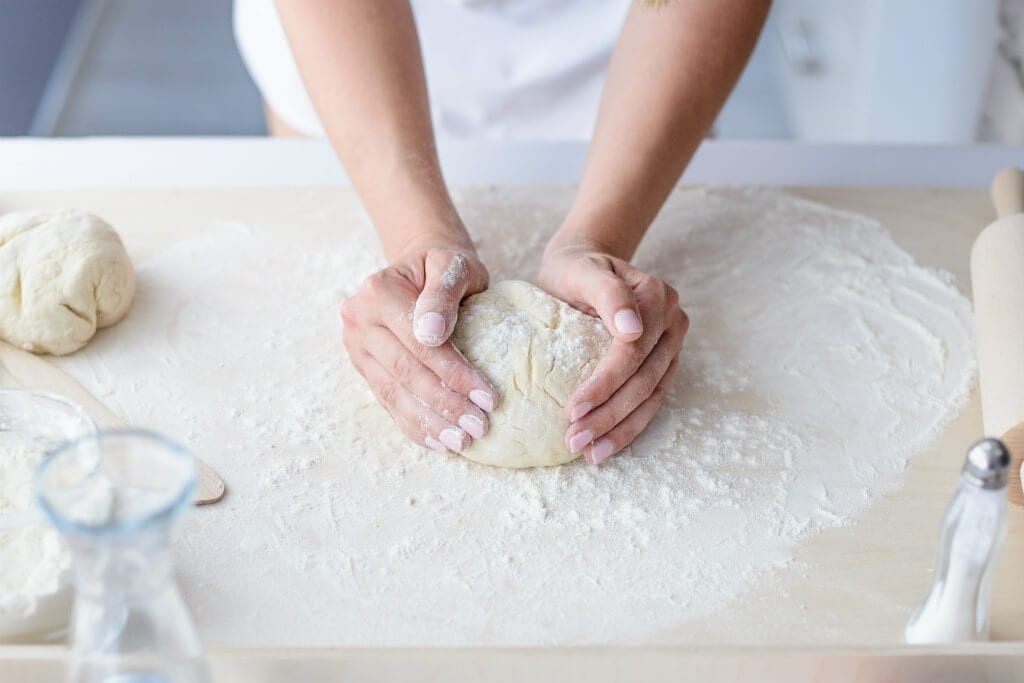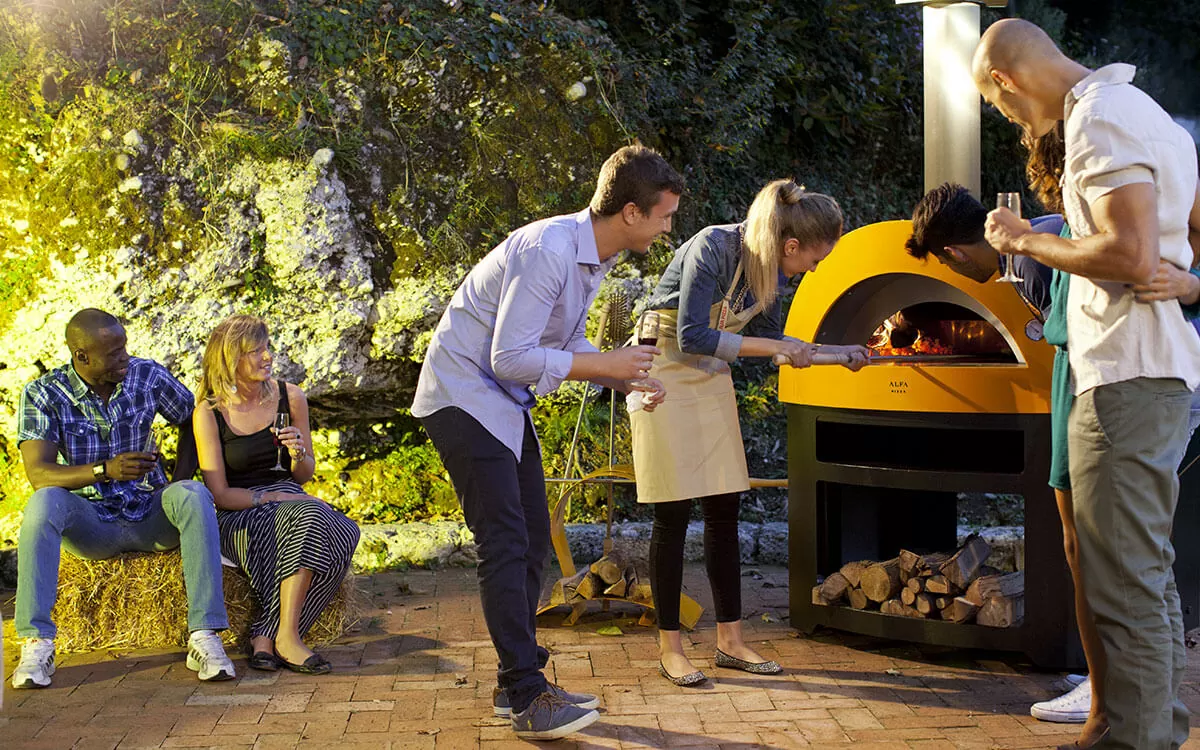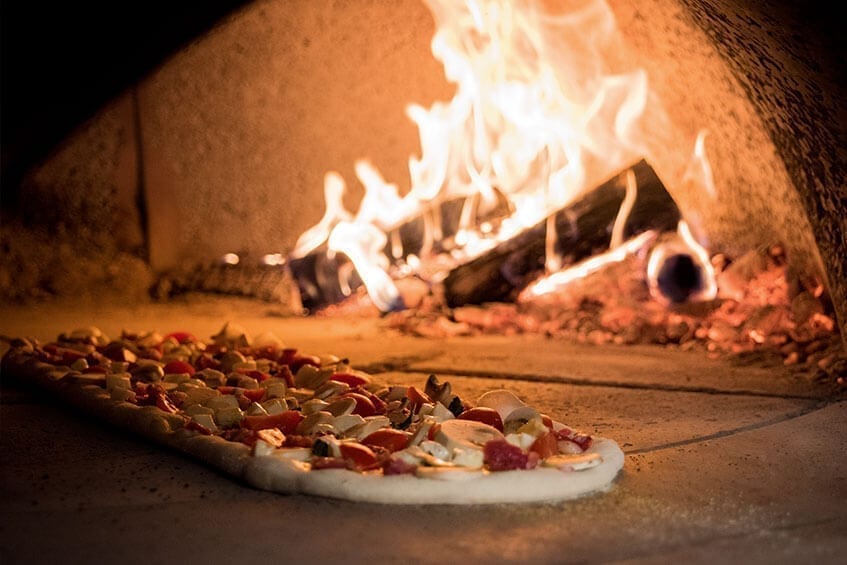One of the most widely known and popular recipes in the world of baking is ‘pizza alla pala’, thanks to some characteristics that make this recipe really quite tasty. The dough for ‘pizza alla pala’ is undoubtedly the most influential parameter in the success of a good product, as it is slightly different from that of traditional pizza, with regard to both the recipe and the baking process.
In this article we will be looking in detail at the theme of ‘pizza alla pala’, providing a guide with numerous tips for making this exquisite version of our favourite dish.
We will start by comparing this preparation with the traditional Neapolitan pizza and with the pizza in a pan, to underline the characteristics of the ‘pizza alla pala’ and to understand why it can be considered a hybrid between the two most famous versions of the pizza we have just mentioned. In fact, we will discuss the features of the dough and the method of preparation, kneading and baking that characterize the making of a ‘pizza alla pala’.
In the second section we will look closely at the actual recipe for a ‘pizza alla pala’ dough, step by step. We will see that the main feature of this dough is a rather high hydration, which makes the product more difficult to work, but capable of giving us an extremely light and tasty pizza.
We will then discuss cooking the ‘pizza alla pala’, describing the method of baking and handling inside the oven. We will see that it is possible to cook ‘pizza alla pala’ in all types of ovens, yet this recipe manages to give its best when it is cooked at high temperatures, enabling us not to dry the dough too much in the central part while leaving it nice and golden-brown on the crust.
Finally, we will conclude by summarizing the main factors for the success of an excellent ‘pizza alla pala’, mentioning the possibilities offered by the Alfa range of domestic ovens. In addition to being excellent cooking tools, our domestic ovens are extremely user-friendly and very efficient from a thermal point of view, managing to reach very high temperatures with low fuel consumption.


The characteristics of a ‘pizza alla pala’
The ‘pizza alla pala’ is a version of the typically Roman pizza quite widespread throughout central Italy, where it can have various names and differences in preparation depending on the local variations.
The characteristics that most differentiate a ‘pizza alla pala’ from other types of pizza can be summarized in two groups, that is:
- The type of dough
- The kneading and baking method
Let’s explore the two points below to see what the peculiarities of this preparation are.
1 . The type of dough
The main feature of the ‘pizza alla pala’ dough is its high hydration, which is at least 70%, yet which can also exceed 80%.
It is worth noting that hydration expresses the weight ratio between water and flour and is one of the most important parameters of dough. This relationship has a decisive influence on all the variables involved in the success of a good pizza, for example in the creation of a strong gluten knead or in the time required for the dough to mature.
The main difference between the ‘pizza alla pala’ dough and that of plate pizza lies precisely in the high hydration, which in traditional Neapolitan pizza is usually around 60-65%. In fact, a plate pizza provides a faster leavening than ‘pizza alla pala’, made possible by the use of weaker flour types (type 0 or 00), that is, flour that is capable of absorbing less water.
A more hydrated dough is also more difficult to handle and this is probably one of the reasons that gave birth to the pizza in a pan (or by the slice). This version of pizza is also extremely popular and appreciated and high-quality products can be found.
The most important feature that the pizza in a pan shares with the ‘pizza alla pala’ is precisely a higher hydration of the dough than the plate pizza, however the main difference lies in the use of a pan as a support for cooking the pizza, since it allows to eliminate the process of baking with a peel and it facilitates the movement of the pizzas.
Another aspect that unites pizza in a pan and ‘pizza alla pala’ is the fact that much larger pieces of dough are made than plate pizza and as a result they allow us to feed more than one person per pizza.
In some ways, therefore, the ‘pizza alla pala’ can be defined as a cross between the plate pizza and a pan pizza, since it is baked with a peel directly on the oven floor, like the plate pizza, yet is has a higher hydration and larger sizes, like the pan pizza.
In the next section, we will explore the characteristics of the ‘pizza alla pala’ dough and go over some tips in making it, but first let’s have a look at the methods of kneading and baking the ‘pizza alla pala’ and the differences in these aspects with the plate pizza.
2 . The kneading and baking method
The second group of factors that characterize the preparation of a ‘pizza alla pala’ concerns everything that happens after the dough ball is ready for the kneading, seasoning, placing in oven and cooking phases.
Numerous manual aspects are involved in these phases and some precautions must be taken, due to the very hydrated dough and therefore more delicate and difficult to knead.
The first precaution to take may seem trivial, but it should not be neglected: the need to flour both the work surface on which we spread the dough and our hands abundantly when we start kneading the leavened dough. This need arises from the fact that a very hydrated dough is often stickier and will absorb a little more flour from the outside in the kneading phase than less hydrated dough (since the latter already contains more flour in percentage).
Speaking of the actual kneading phase, it is worth noting that our goal is to have a homogeneous pizza base, that is, of the same thickness in all areas and above all without any thin areas, which could cause the dough to stick to the work surface or to the peel, or even worse it could create a hole in the pizza inside the oven.
Well-rolled kneading also improves dough consistency during cooking, with the result of obtaining a pizza with the same degree of cooking in all areas, without having a drier area if it is thinner or too soft inside if it is left too high in the middle.
Depending on one’s tastes, we can also leave a very pronounced crust, recalling the Neapolitan style, or a more contained one resembling a pan pizza.
The best way to knead a ‘pizza alla pala’ dough ball is to try to move the air that has been created inside it without letting it escape. To do this, we need to gently massage the dough without crushing it too much while using plenty of flour under it, repeating the process on both sides of the dough ball.
The big difference between kneading a ‘pizza alla pala’ and a plate pizza lies in the movement of the hands, both in the way in which the dough is touched and in the directions in which they move. The ‘pizza alla pala’ is in fact characterized by a more or less rectangular form, given by the shape of the peel itself. In order to obtain a pizza of this shape, the hands work side by side moving the dough in a vertical direction, while when kneading a round pizza they carry out a rotary movement moving away from each other.
Once we have given an almost complete shape to the base of our ‘pizza alla pala’ (i.e. a slightly rounded rectangle, slightly larger than a plate pizza), we lift it to shake off the excess flour and place it on the clean and freshly sprinkled surface with a pinch of flour.
We are now ready for the topping, which we will not dwell on since it is exactly the same as for the other types of pizza. The only fundamental rule that we’d like to highlight is to prepare the various ingredients of the right size based on the cooking time and temperature, so as to have each ingredient cooked to perfection, when the dough is well cooked.
The main peculiarity of placing a ‘pizza alla pala’ in the oven is that this phase plays a fundamental role in the success of the pizza, since it determines its final form, thanks to the shape of the instrument.
Similarly to a round pizza, we slide the peel under our pizza with snappy movements. When all of the pizza is on the peel we can proceed with a further light spread, until all the lateral edges of the peel are covered.
The last lengthening of the pizza takes place when it is put in the oven, when we let the pizza descend from the peel gradually while pulling it towards the mouth of the oven, thus managing to further lengthen it and obtain the shape of a rounded rectangle.
A ‘pizza alla pala’ is considered as two round pizzas (or eight slices), thus as a reference we can say that a 550-600 grams dough ball can provide a ‘pizza alla pala’ for two people which is 35-40 cm wide and 60-70 cm long.
We will look more closely the topic of cooking in the third section, but for now we can state that the above is obviously highly influenced by the type of oven used. However, we can generalize by saying that the two types of pizza usually share the need to be rotated 180° to obtain uniform cooking.
After having seen the main characteristics of a ‘pizza alla pala’ and the differences in its preparation compared to other types of pizza, let’s now have a look at some tips to obtain excellent ‘pizza alla pala’ dough.

How to make the dough for ‘pizza alla pala’
We already mentioned some useful tips in creating and handling highly hydrated dough, which needs a slightly more developed manual skill (nothing that cannot be learned with a little practice).
In order to create a very hydrated, yet tenacious, dough that is not too difficult to knead, we need to take some precautions regarding both the actual recipe and the method of handling the dough once its preparation has been completed.
If this is the first time you’re trying to make this type of dough, we suggest you don’t exaggerate with the amount of water used and to keep the hydration around 70%, and then gradually increase it as you practice.
For two ‘pizza alla pala’ (four people), we can use 500 grams of flour and 350-360 of water. To complete the list of our ingredients, add roughly 13 grams of salt (40 per litre of water), the same amount of extra virgin olive oil and 2-3 grams of dry brewer’s yeast (or double if it’s fresh).
After having seen the ingredients we need, we have to make some considerations on the choice of the flour mix. We said that we need a mix of strong flours to be able to incorporate plenty of water into the dough, while still obtaining good tenacity and a strong gluten knead.
You can try mixing various types of soft wheat flour (0, 00, type 1, type 2 and wholemeal) with other types of flour such as soy or rice, or with durum wheat semolina.
At this point, we must also consider the fact that stronger flours and high hydration involve extending the maturation times, or rather the process of transforming complex molecules into simpler structures; the crucial factor for obtaining a light and easily digestible pizza.
Therefore, having to align the maturation times with those of leavening, the dough for a ‘pizza alla pala’ is usually made one, or even two days before cooking and is kept in the refrigerator to slow down the leavening.
Other very useful tips for preparing an easy-to-work ‘pizza alla pala’ dough concern the actual dough process, i.e. when we begin to combine the ingredients.
The first trick that is usually used to help the formation of gluten, not only in the dough for ‘pizza alla pala’ but in general in all highly hydrated or very heavy doughs (for example panettone), is the downtime, or technically speaking: flour autolysis.
Autolysis is a technique that involves making a pre-dough with an abundant half of the total water that we will use to begin kneading with roughly the same amount of flour, to then pause for at least an hour. At this stage, we do not have to form the actual dough, whereby it is sufficient that there is no dry flour and just one minute stirring is enough.
Leaving unfinished dough to rest helps the flour absorb more water and develop gluten better, which is strengthened every time we knead and then let the dough rest.
After the resting time, we can proceed with the ‘pizza alla pala’ dough by adding the remaining part of flour and another large part of water with the dissolved yeast.
The speed of the kneading machine must always be kept to a minimum, to avoid overheating the dough during processing. In the summer, it is also advisable to use cold water for this purpose. This problem does not arise if we knead by hand, but some practice is required to create a very hydrated but tenacious dough without the aid of a kneading machine.
The speed should be increased slightly only when the dough is almost finished, after taking a second break so as not to put too much stress on the gluten knead we are forming and after adding the remaining ingredients, i.e. salt, oil and the remaining part of water. (very gradually).
Once you have finished adding all the ingredients and when you see that the dough is “strung” (smooth and homogeneous, not sticky and very elastic, which does not tear easily), you can gently place it in a container that can hold at least three times its size, in order to leave enough air even when it has doubled in volume.
After letting it rest for at least half an hour at room temperature to start leavening, the dough should be put in the fridge for at least 12-16 hours, in order to obtain a first doubling in volume very slowly, thus aligning the leavening and maturation.
About three or four hours before the preparation of the pizza (depending on the amount of yeast and the room temperature), you can remove the dough from the fridge and we recommend waiting a few dozen minutes to allow it to get to room temperature before starting to work it.
We can now proceed with the formation of the dough balls for the ‘pizza alla pala’. We mentioned that usually portions are made corresponding to two round pizzas, but with a larger oven and peel we can increase the size of our pizza.
The composition of the dough balls is quite similar to that of bread, having to close the dough inwards to form a sort of external skin, which contains all the dough well sealed. At this point we can let the ‘pizza al pala’ dough rise to room temperature until the volume is doubled again after which we will be ready for the stretching, seasoning and the baking, which we have illustrated previously.

How to cook to perfection a ‘pizza alla pala’ with an Alfa oven in your home
Let’s now explore the topic of cooking a ‘pizza alla pala’, seeing how to obtain optimal results based on the type of oven.
The Alfa range of domestic ovens includes models that are spacious enough to bake two ‘pizza alla pala’ simultaneously, such as the Allegro, the Dolce Vita or the 4 Pizze wood-fired steel ovens, in addition to the traditional wood-burning oven models.
As for fuelling the oven, we can say that a ‘pizza alla pala’ can be made in all fairly large ovens, but it needs a strong heat boost to swell as best as possible during the final leavening of the dough (during cooking).
It is also true, however, that a very hydrated dough can better withstand a longer stay in the oven without drying out too much, thus achieving good cooking consistency even around 300° C. On the other hand, cooking at a temperature above 450° C, as can happen for pizzas cooked in a wood oven, could leave the central part of the dough still not cooked enough when the outside is already nice and crunchy. The ideal cooking temperature for ‘pizza alla pala’ dough is therefore between 350 and 400° C.
As regards fuelling the oven, it is obviously possible to choose both gas and wood-burning tools, while for domestic use electric ovens are not recommended as they do not reach very high temperatures (due to high consumption).
In a nutshell, the advantages of a wood oven are the natural aroma that the fuel gives to the dishes and the ability to reach very high temperatures, while in favour of gas ovens there is certainly an extreme ease of handling and more homogeneous cooking in the various areas of the oven.
Alfa domestic ovens are cooking tools with performances comparable to professional ovens, perfect for an outdoor kitchen to be taken advantage of during the summer.
Thanks to their well-finished design and the ability to be moved when used, our mobile steel ovens allow you to furnish the house’s outdoor areas and to use them to create extraordinary cooked dishes.
One of our solutions will no doubt enable you to make excellent pizzas, both on a plate and on a peel, as well as many other oven recipes such as firsts, seconds, side dishes or desserts. All you need to do is choose the right oven for your space and try your hand at making ‘pizza alla pala’ at home. By following our advice, and with a little practice, you will certainly be able to obtain excellent results with the pizza dough and its perfect cooking.


